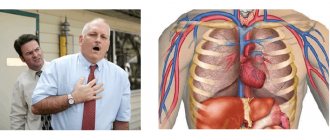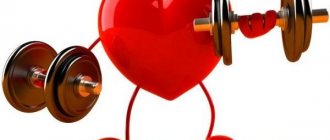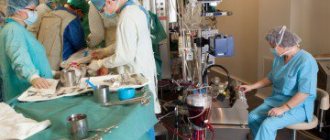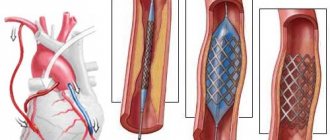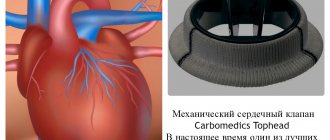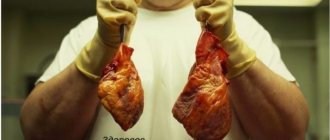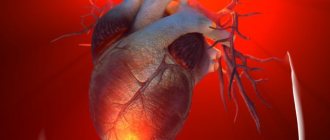How to identify yourself
It is imperative to pay attention to the symptoms that accompany the temperature. Even a slight increase in temperature is often combined with weakness, decreased performance, and sometimes headaches. The following signs may indicate heart problems:
- Cough. Dry and long-lasting, sputum may gradually appear, sometimes even streaked with blood. There are several differences from a cold cough: duration, attacks in a lying position, it weakens when taking a vertical position.
- Dyspnea. Appears even against the background of slight physical activity.
- Chest pain of various types. Sometimes they are felt throughout the chest and in the back.
- Aches in the joints. This symptom is also characteristic of the flu, but rheumatism can also manifest itself in this way.
- Increased blood pressure and pulse rate.
We will talk further about the reasons leading to an increase in body temperature in the evening and during the day in a child and an adult.
Can there be a temperature with heart disease?
Timely diagnosis of diseases of the cardiovascular system is extremely important, since a fully functioning heart and healthy blood vessels are the key to adequate blood supply to all organs and systems of the body.
In a certain proportion of cases, even serious heart diseases are asymptomatic, but often cardiac patients (that is, people with cardiac pathology) present typical complaints, on the basis of which one or another disease can be suspected.
What symptoms are we talking about? Let's look at it below.
Main signs of heart pathology
The main signs of heart pathology are:
- pain in the chest area, especially behind the sternum;
- feeling of shortness of breath, or shortness of breath;
- interruptions in the functioning of the heart, rapid heartbeat (tachycardia);
- swelling;
- dizziness and periodic loss of consciousness;
- weakness, fatigue;
- heaviness, pain in the right hypochondrium.
Also, cardiac pathology may be indicated by hoarseness and cough, complete lack of appetite (anorexia), increased body temperature (hyperthermia) and frequent night urination, or nocturia.
Chest pain
Pain in the chest area (so-called cardialgia) is the most common symptom of heart pathology, but it can be caused by diseases not only of the heart, but also of other organs and systems.
The following heart diseases can cause chest pain:
Coronary heart disease (CHD) is the cause of more than 50% of all cardialgia. Its most dangerous forms are angina pectoris and myocardial infarction. Angina pectoris has a number of signs, based on which it is not difficult to suspect this particular pathology:
- the pain is localized behind the sternum, can radiate (give) to the left arm, left shoulder blade, left half of the neck;
- usually an attack of pain lasts from one to fifteen minutes;
- the pain, as a rule, is intense, has a burning, pressing, squeezing character, accompanied by the fear of death, often cold sweat;
- a painful attack occurs after physical or emotional stress, overeating, exposure to cold;
- Pain is relieved by rest, a semi-sitting position in bed, and taking nitroglycerin.
With a form of coronary artery disease such as diffuse cardiosclerosis, the pain is usually mild or moderate in intensity, often has a stabbing nature, and can last for a moment or maybe several hours.
In hypertension, cardialgia occurs against the background of increased blood pressure and increased heart rate, their nature is uncertain.
Heart valve defects are also accompanied by pain in the heart, most pronounced with aortic valve stenosis (the characteristics of the pain are similar to angina pectoris).
Pain in the heart with pericarditis is long-lasting, often constant, and worsens with breathing and coughing. It may decrease with the patient sitting and worsen with the patient lying on his back.
Myocarditis is also characterized by prolonged aching pain. Often they are accompanied by certain disturbances in heart rhythm, expansion of its boundaries and the appearance of noise in the apex.
Cardialgia in cardiomyopathies is of an uncertain nature and is usually not associated with physical activity.
There are many reasons that cause pain in the heart area, but are not related to pathology in this organ. The main ones:
- cardialgia with osteochondrosis of the cervicothoracic spine (or vertebrogenic cardialgia) is the second most common cause of heart pain after ischemic heart disease;
- diseases of the esophagus (cardiospasm, reflux esophagitis, diverticula and tumors);
- pathology of the thyroid gland (both hyper- and hypothyroidism);
- diseases of the pleura (pleurisy, tumors, pneumonia, pneumothorax);
- herpes zoster;
- cardiopsychoneurosis;
- diseases of the muscles of the chest and ribs.
Dyspnea
Dyspnea is the patient's own feeling of inadequate, difficult breathing, a feeling of lack of air. This symptom is an important sign of pathology of the heart and lungs.
In heart disease, it has an inspiratory (that is, it is difficult for the patient to inhale) or mixed character and is considered a pathology only if it occurs under loads that did not previously cause it, or at rest; worsens when lying down, decreases when moving to a sitting or standing position.
The main cardiac causes of shortness of breath are:
- left heart failure;
- PE (pulmonary embolism);
- myocardial pathology (infarction, left ventricular aneurysm, cardiomyopathy, cardiosclerosis, myocarditis);
- acute heart rhythm disturbances;
- heart valve defects;
- hypertensive crisis;
- angina pectoris;
- vasculitis, in particular periarteritis nodosa.
Interruptions in heart function, palpitations
A healthy person does not feel the work of his heart. Moreover, not too serious disturbances in heart rhythm are often not felt by the patient.
But the majority of cardiac patients can characterize the work of their heart: “it jumps out of the chest,” “it seems to freeze, stop,” “it beats faster, then slower.” These complaints are signs of arrhythmias - disturbances in the rhythm and conduction of the heart.
Swelling, heaviness and pain in the right hypochondrium
These symptoms are nothing more than signs of heart failure. At its early stage, edema may not be noticeable from the outside, but present inside the body: so-called hidden edema.
As heart failure progresses, peripheral edema appears - on the feet, lower third of the leg. They become noticeable in the evening.
Edema is easy to diagnose yourself: when you press it with your finger, a dent appears and lasts for 30-40 seconds.
From the edema observed in chronic insufficiency of the veins of the lower extremities, cardiac edema differs in its symmetrical location - on both extremities equally.
If left untreated, swelling spreads higher - to the legs, thighs, and in advanced cases - to the area of the buttocks and external genitalia; then the fluid begins to accumulate not only in the subcutaneous fatty tissue, but also in the body cavities (for example, in the abdominal cavity, this is called ascites) - anasarca develops.
In case of anasarca, measures should be taken as quickly as possible: due to tissue necrosis and serious dysfunction of various abdominal organs, fluid is not absorbed, forming accumulations.
In parallel with the appearance of edema, the patient often begins to notice first discomfort, heaviness, and then pain in the right hypochondrium. These phenomena are associated with congestion in the systemic circulation and are caused by an enlarged liver, which, in the absence of the necessary therapy, sooner or later develops cirrhosis.
Loss of consciousness, dizziness
Heart patients, due to deterioration of blood supply to the brain, may experience dizziness, lightheadedness, or fainting. This is usually observed when:
- various arrhythmias (such as sinus node failure, ventricular tachycardia, paroxysmal supraventricular tachycardia and others);
- obstructive changes in blood vessels (stenosis of the aortic or pulmonary artery, tetralogy of Fallot, atrial thrombosis, left atrial myxoma and others);
- due to stress (neurocardiogenic fainting - syncope);
- due to a sudden change in body position (postural hypotension).
Loss of consciousness due to heart pathology is not accompanied by convulsions and urinary incontinence.
Weakness, increased fatigue
These complaints are usually made by patients with heart failure, since in this condition cardiac output decreases, and organs and systems, in particular the musculoskeletal system, lack oxygen and other nutrients. Weakness worsens with exercise, and decreased exercise tolerance has important diagnostic implications.
As mentioned at the beginning, less specific signs of heart disease include:
- cough – occurs when the airways are compressed by a tumor of the heart and aorta, infarction and alveolar pulmonary edema, heart failure; in most cases it is dry, obsessive, but in pulmonary edema it is moist, with pink frothy sputum, and in pulmonary infarction it is streaked with blood;
- Hoarseness of voice – usually associated with compression of the laryngeal nerve by an enlarged left atrium or an aortic aneurysm;
- increased body temperature (hyperthermia) – observed in patients suffering from infective endocarditis, myocarditis or cardiac complications of an infectious process of a different localization;
- frequent urination at night (nocturia) – occurs in patients with congestive heart failure;
- increasing anorexia, rapid weight loss and, finally, exhaustion occur in advanced forms of chronic heart failure; are a very serious symptom that needs urgent correction.
Source: https://lechimsosudy.com/mozhet-li-byt-temperatura-pri-serdechnyh/
Survey plan
Usually there are no problems with diagnostics; after clarifying the complaints, we can assume the source of the problem. But if the conversation with the patient does not bring clarity, then the examination plan usually looks like this.
Blood analysis
It may indirectly indicate the presence of a virus (increased level of lymphocytes) or bacterial (high concentration of leukocytes, especially neutrophils).
General urine analysis
Allows you to identify signs of inflammation in the urine by indicators such as the number of leukocytes and the presence of nitrites - a waste product of certain microorganisms. If bacteria are present, a special, clarifying study can be carried out to identify the likely pathogen.
Chest X-ray
An indispensable tool for identifying pneumonia and some other pathological processes. In case of heart failure, fluid in the lungs deserves close attention, especially when detected for the first time. Occasionally, distinguishing pulmonary congestion from inflammation on an x-ray can be challenging. This may require repeating the images several times.
Ultrasound of the abdomen
Ultrasound is used when a standard examination does not reveal the cause of the temperature.
Ascites in heart failure can sometimes become infected with bacteria, but then the temperature will be accompanied by abdominal pain and the general condition becomes severe.
Of course, in some cases the reason may lie on the surface. Often, temperature in heart failure appears due to inflammation of the skin and subcutaneous tissue in the area of swelling of the legs. But it is often necessary to significantly expand the search area, and here everything depends on the duration of the temperature, its severity and the presence of accompanying symptoms.
What could a rise in temperature indicate?
Heart problems
An increase in temperature can occur under the influence of ARVI or, for example, during prolonged exposure to the sun. Many disorders in the body are accompanied by its rise, especially those of an inflammatory nature.
But the symptom is most dangerous in the presence of heart disease. It may indicate the following problems:
- rheumatism in the acute phase;
- tachycardia;
- endocarditis;
- heart failure;
- embolism and thrombophlebitis;
- heart weakness;
- IHD;
- arrhythmia;
- myocarditis, pericarditis and other inflammatory pathologies of the heart;
- myocardial infarction;
- heart disease.
Scientists have found that a prolonged feverish state associated with a rise in temperature is dangerous for the muscle layer that has already been damaged (for example, during myocardial infarction).
Sometimes with heart disease, a rise in temperature occurs while taking certain medications. In this case, the symptom is accompanied by a skin rash, itching and a number of other side effects. The exact nature is clarified after examinations. If the reason really lies in the medicine, the doctor will replace it with a suitable one and monitor that no side effects appear in the future.
Other diseases
In addition to heart disease, the symptom accompanies problems such as:
- cystitis;
- thyroid diseases;
- oncology;
- prostatitis;
- viral hepatitis;
- pyelonephritis;
- bronchial asthma;
- chronic diseases (bronchitis, salpingoophoritis, etc.),
- cold, sore throat.
The effect of high temperature on the functioning of the body
The common cold, which often causes a fever, is not a cause for concern for everyone.
In most cases, such an illness goes away without a trace and does not provoke serious consequences. When infectious agents enter the human body, a natural immune response occurs, which is aimed at destroying bacteria. The action of this process is as follows: pathogenic elements that penetrate the body begin to actively synthesize toxic substances, which are protein compounds, and the presence of foreign components gives rise to a series of biochemical reactions for the intensive production of special antibodies.
A high rate of hyperemia will certainly cause fever, which is accompanied by pain and other unpleasant symptoms. Many people try to cope with such discomfort with the help of various medications, but they practically fail.
Hyperemia is a factor that forces the main organ to work harder. This occurs due to metabolic disorders, changes in the quality and total volume of circulating blood, as well as due to a rapid breakdown of water-salt balance.
An increased temperature causes an increase in the rate of beating of the main organ, changes in blood pressure, and centralization of blood flow. These pathologies provoke a deterioration in a person’s well-being.
Signs:
- headache;
- convulsive manifestations;
- disturbances of consciousness;
- dizziness;
- severe weakness.
If a person has cardiac diseases, then the cold factor will cause severe symptoms and increase the risk of complications. When fever occurs in such patients, sinus-type arrhythmia is recorded.
Fever, high pulse and heart pain may indicate severe disorders, which are often acute heart failure or polycythemia, caused by an increase in the total number of red blood cells.
Among other things, fever threatens chronic cerebral circulatory failure and other dangerous consequences. However, a sharp decrease in the manifestations of hyperemia can also provoke serious deviations. Antipyretics act quickly, reducing the temperature.
Not all patients with colds are prone to such disorders; much depends on the person’s age, his general health and other factors. It is necessary to take action as soon as a runny nose or other first signs of a cold infection appear, then it will be easier for the body to cope with this disease.
A common disease is tonsillitis, which affects the tonsils of the palate and is accompanied by high fever. Many people do not consider it necessary to properly treat this disease or start therapy untimely, then complications develop in the form of pathologies of the cardiovascular system.
A similar process destroys the tissue of the endocardium, myocardium, and pericardium. In addition, one can observe the development of a chronic rheumatic disorder, as a result of which an acquired type of organ defect occurs, leading to disruption of the activity of the entire valve apparatus.
Another unfavorable factor caused by angina is myocarditis or muscle damage to the main organ of an inflammatory nature. This condition leads to a failure of all functional features of the heart.
It is important to take seriously any illness that causes a fever. Especially if there is pain in the heart and fever, diagnosis and proper therapy are necessary to prevent the development of complications.
The cause of problems in the main organ may lie not only in hyperemia, because there are cardiac pathologies in which such a disorder is a consequence and not a provoking factor. With many diseases of the cardiovascular system, an increase in body temperature is observed, which some people mistakenly perceive as a symptom of a cold.
Descriptions of pain in the heart during heat can vary; such sensations are often stabbing and aching in nature, but can become acute and unbearable. The load on the main organ caused by high temperature provokes disorders.
Depending on how the body suffered the disease and coped with such a disorder in the activity of all systems, pain in the heart area appears. Often such unpleasant moments are associated with tachycardia; a rapid heart rate leads to pain, which is sometimes observed for a short time and does not pose a danger.
An increase in heart rate is a normal response to hyperemia, but it is important to control this process. A strong increase in this indicator can lead to serious consequences. Tachycardia during a cold that occurs without fever requires consultation with a doctor, as it indicates serious problems in the body.
| Person's age | Average normal values |
| From birth to 1 month | 139-141 |
| From 1 year to 2 years | 131-125 |
| 4-8 years | 105-99 |
| 10-12 years | 87-81 |
| From 12 to 15 years old | 74-71 |
| 15-50 years | 69-71 |
| 50-60 years | 73-75 |
| 60-80 years | 78-80 |
Fever and pain in the heart area can be related, since an increase in temperature even by 1 degree increases the normal rate of contraction of the organ by 8-10 beats for an adult, and 11-15 beats for a child.
Consequently, with hyperemia above 38 degrees and up to 40 degrees, the heartbeat increases significantly, and this can cause unpleasant sensations in the chest, even when the thermometer readings have already stabilized.
How to deal with this symptom
Commonly accepted means
- It is necessary to take antipyretics at a temperature of 38.5 C, and if febrile convulsions were previously noted, then the medications are taken even earlier (at 37.5 C).
- You must remember to drink plenty of warm water, and if it is delayed, drink diuretics. This will help bring the condition back to normal faster. It is better to use drugs in rare cases, but you should not delay a visit to the doctor. For short-term treatment, you can use the following before use: Paracetamol,
- Analgin,
- Nurofen,
- Aspirin,
- Ibuprofen.
If the temperature is elevated for a long time, a mandatory examination is necessary. It can be difficult to accurately determine the diagnosis when visiting one doctor, so it is better to undergo examination by several doctors. There can be many reasons for this problem, but constantly taking antipyretics and antibiotics is strictly prohibited.
Self-medication with such serious drugs can lead to a deterioration in heart function, which, against the background of the underlying pathology, will lead to a worsening of the condition.
It will be possible to avoid a rise in temperature in the future if you follow all the recommendations given regarding the treatment of the disease that provokes the symptom. Additionally, it is worth taking a course of physiotherapeutic procedures (massage, mud therapy, balneotherapy, etc.) to improve immunity.
This video will tell you how to lower a child’s temperature:
Folk remedies
There are enough recipes from alternative medicine that have an antipyretic effect. Along with prescribed medications, it is also worth using decoctions aimed at strengthening muscles and reducing inflammation (from rose hips, hawthorn). It is better to consult your doctor regarding the use of each recipe.
The following recipes can help with cardiac pathology that provokes fever:
- Drinking plenty of fluids includes not only water, but also, for example, fruit drinks. Particular attention should be paid to decoctions and fruit drinks made from cranberries, lingonberries, sea buckthorn, and currants.
- A decoction can be prepared from claspberry, elderberry leaves and nettle. Rosehip, rowan and linden tea also have antipyretic properties.
- Honey (0.5 tbsp) is mixed with propolis and crushed garlic (1 tsp each). Take 4-5 spoons per day.
- Lemon juice is mixed with water and honey is added. Leave the product for 20 minutes and drink. You can repeat the reception up to 4 times a day.
- To relieve heat, apply a potato compress to the forehead. Raw potato gruel is mixed with apple cider vinegar (1 tbsp) and applied to the forehead (in gauze). If necessary, the compress is changed periodically.
Among the folk remedies for fever, you need to avoid recipes containing Rhodiola rosea and St. John's wort. And, of course, self-medication can be dangerous, so neglecting qualified help is not recommended.
This video will tell you about folk remedies and methods that help lower the temperature:
Symptoms of pathology
Most often, the patient experiences the following symptoms:
- discomfort in the chest,
- labored breathing,
- pain in the shoulder joint and sometimes in the fingers,
- cold sweating,
- nausea,
- fatigue,
- wheezing.
Based on these symptoms, cardiac risk can be assessed. It is impossible to accurately predict whether a temperature will manifest itself during a heart attack.
Before the medical team arrives, the patient must be given first aid. The person should lie down in bed and not get up; you can also take medications such as Karvasin, Trinitrina or Naspaprey.
If the pain is mild and there are no other problems, you can go to the emergency room on your own or see a doctor immediately. In a medical facility, a doctor assesses the patient's condition. A thorough examination is performed, one or more electrocardiograms are done to look for signs of a heart disorder, and blood is drawn for testing. At this stage, it is important to provide all the information about the type of disease, treatment methods and medications taken, as well as provide old cardiac studies. If the patient is hospitalized for a few hours, most likely there is no serious heart problem. In this case, the doctor performs the following actions:
- chest x-ray,
- echocardiography,
- myocardial enzyme monitoring or monitoring,
- electrocardiography in 3D format.
If the assessed risk is minimal, then the diagnostic process ends. Otherwise, the examination continues, during which doctors determine the most appropriate diagnosis and method of admission: coronary care unit, coronary semi-intensive care or emergency medicine.
Cardiac ailments and fever
High and low temperature in a person suffering from heart pathologies may be a sign of the development of complications. Such patients need to carefully monitor these data. Since an increase in heat causes tachycardia, this does not have the best effect on the condition and functioning of the main organ, and in the presence of diseases in this area, the situation can become extremely difficult. There are symptoms that indicate problems in this area with hyperemia.
Signs:
- Difficulty breathing, shortness of breath. This manifestation can occur even against the background of mild physical activity.
- Aching sensation in the joints. Similar symptoms often accompany the flu, but are also characteristic of rheumatic lesions.
- Cough. This symptom of a cardiac nature is difficult to distinguish from the manifestations of a cold. A cough of the cardiac type is prolonged, worsening in a lying position, and as soon as a person sits down, the intensity of the cough decreases. There is usually no sputum, but gradually it can be released, sometimes mixed with streaks of blood.
- Increased blood pressure, pulse also increases.
- Painful sensations in the sternum area, of a different nature, often radiating to other parts of the body and the back.
If your body temperature is about 37 degrees and your heart hurts, this is already a cause for concern; those who have been diagnosed with cardiac diseases should especially worry.
What diseases are dangerous:
- Tachycardia, in which the heart can beat at twice its normal speed.
- Heart failure. With hyperemia, all manifestations of this pathology intensify, which is deadly.
- Acute rheumatism.
- Coronary heart disease, which seriously impairs the functioning of the organ, and together with fever can lead to extremely serious conditions.
- Thrombophlebitis, as well as embolism.
- Endocarditis.
- Myocardial infarction.
- Heart weakness.
- Organ defects.
- Pericarditis or myocarditis, as well as other inflammatory heart diseases.
When the body temperature rises, the heart loses a lot of energy, it begins to beat faster, which causes pain in the sternum. If there are no symptoms indicating myocardial damage, then doctors are treating the underlying disease.
What to do?
Temperature during tachycardia indicates the presence of an inflammatory process in the body. There are several factors that contribute to increased beating of the main organ during the course of ARVI.
- Colds disrupt the functioning of the nervous system, this leads to increased sensitivity in this department, due to which the production of nerve impulses, and therefore the heartbeat, increases.
- With influenza and respiratory infections, immune defense is significantly reduced; this system is no longer able to fully resist the attack of viruses and other bacteria. Some of these pathogenic elements penetrate inside the body, disrupting the activity of its various areas, including the heart.
- Everyone knows that colds lead to exacerbation of any chronic diseases, this also applies to cardiac ailments. Such viral agents can lead to the development of heart failure, as well as myocardial infarction.
It is important during this difficult period to follow all the doctor’s instructions in order to maximally help your body cope with the problem and prevent the occurrence of serious complications.
Actions:
- Drink a lot of water and various drinks in the form of fruit drinks, tea, compote. This will speed up metabolic processes and recovery will come faster.
- Maintain bed rest, this is necessary.
- Take all prescribed medications.
- Quit smoking and give up alcohol.
- Ventilate the room several times a day, even if the patient is hot and sweats a lot.
- Remove fatty, spicy foods, as well as drinks containing caffeine from the patient's diet.
- Get proper rest and sleep.
If the patient has heart pain, a rapid organ rhythm and hyperemia are recorded, then the doctor needs to decide where to start therapy. As a rule, the first stage of treatment for a patient is the prescription of medications for the main ailment, that is, a cold infection.
By eliminating this pathology, cardiac problems will also go away. However, often the patient needs help in terms of cardiac abnormalities, in which case careful diagnosis and correction of therapy are necessary.
Most commonly prescribed drugs:
- Antiviral medications that fight infectious and viral microorganisms. "Amiksin", "Amizon", "Arbidol".
- Antipyretics, necessary to stabilize temperature indicators and destroy pathogenic elements. "Milistan", "Ibuprofen", "Paracetamol".
- Beta blocker drugs. These medications reduce the effect of stress hormones on the body. "Metoprolol", "Acebutalol".
- Cardiac glycosides. "Cordarone", "Sotahexal".
- Vasoconstrictor medications. "Naphazoline", "Tetrizoline", "Phenylephrine".
- Antioxidants that improve blood circulation. "Preductal", "Mexico".
Low immunity can affect the duration and intensity of any illness, so care must be taken to restore it. Taking vitamin complexes will speed up this process.
Heart pain, fever and tachycardia during colds are dangerous symptoms that should be reported to your doctor immediately. Today there are ways to quickly help such patients; it is important to seek medical advice and treatment in a timely manner.
Who is susceptible to heart attack?
The development of a pathological process in the cardiac system is facilitated by stress, infections, and anemia. A heart attack can be prevented by:
- blood pressure control,
- control blood sugar levels in diabetes,
- cholesterol control,
- effective drugs for blocking processes that cause thrombosis (thrombolytics).
Can there be a fever during a heart attack? Yes, this is likely, although low marks are most often characteristic. Increased temperature during MI occurs most often in elderly people with small focal myocardial infarction. Men after 35-40 years of age and women after menopause are at risk, since structural changes occur in the body during this period of time. Also susceptible to the disorder are people who:
- smoke,
- have diabetes
- suffering from arterial hypertension,
- hypercholesterolemia,
- genetic predisposition.
Complications from a heart attack occur in most patients before they are admitted to the hospital, usually due to arrhythmia. On the other hand, with surgery in an equipped center, complications cannot be completely resolved. However, if emergency medical care is performed in a qualified manner, the consequences of a heart attack will be minimal. A heart attack occurs when the direct flow of blood to part of the heart muscle is blocked due to obstruction of one or more arteries; if blood flow is not restored quickly, the affected part of the heart becomes damaged due to lack of oxygen and begins to die.
Diagnosis of the disease
Diagnosis is made based on symptoms, personal medical history, and examination results, which include:
- Electrocardiogram (ECG). Some changes in the appearance of ECG electrical waves are important signs of myocardial infarction. Even abnormal heartbeats, always read by an ECG, can be the cause of a heart attack.
- Blood tests: These can detect increased amounts of proteins, which are associated with heart attacks. Among them are troponins, CK or CK-MB. These tests must be repeated over time, usually after three, six and nine hours, to analyze their appearance over the entire period.
- Coronary angiography: a special X-ray examination of the heart and blood vessels that is needed to detect a heart attack.
Signs of illness
In many cases, myocardial infarction is accompanied by symptoms common to different diseases. The patient experiences pain in the chest or angina that occurs during movement, expression of emotion, or for no apparent reason. This pain can be of variable intensity, located in the center of the chest or in the back of it. The patient may feel ticking, pain, burning, and severe toothache. Also, the intensity of the pain varies, depending on its manifestation: it can be short or long-lasting, and the malaise is accompanied by a feeling of extreme fatigue, nausea and profuse sweating.
The pain, which in this case can be of variable location and duration, resembles more of a burning sensation than typical angina. Symptoms of a heart attack in women can be different and less obvious than those seen in men. In addition to the general symptoms, the fair sex may experience symptoms such as abdominal pain or heartburn, prickly heat, dizziness, and tinnitus.
Most heart attacks occur due to the formation of a blood clot that prevents oxygen and nutrients from reaching the cardiovascular system. Typically, thrombosis occurs on atherosclerotic plaque due to the accumulation of cholesterol and cells that slowly develop in the coronary artery, leading to rupture of soft tissue. Such a lesion causes platelet aggregation and the formation of a blood clot on the surface of the vessel.
Signs of heart disease: symptoms and recommendations
Article last updated 09.09.2019
Elevated body temperature is not a sign of heart failure, but this symptom should be treated with particular caution. People suffering from heart failure, especially the elderly, are predisposed to any infections and suffer them more severely than others. A common cold can worsen the course of cardiac pathology and lead to serious consequences.
First of all, it must be said that temperatures below 37-37.3 degrees are regarded as normal. If the numbers are higher, then you need to look for the source.
Early signs of a heart attack
Temperature increases are divided into categories:
- very high (more than 39 C);
- moderately elevated (37-38 C);
- low-grade fever.
We will talk about the signs of the process of increasing body temperature below.
As already mentioned, chest discomfort can have various causes. Heart diseases are identified by certain characteristic signs.
You should know that the “core” often does not experience any unpleasant sensations. At the same time, a person with other pathologies may complain that it is difficult for him to breathe or his heart hurts.
However, these symptoms will have nothing to do with cardiac diseases.
1. Compressive, pressing pain behind the sternum, radiating to the back, arm, neck, jaw, especially to the left side. Accompanied by shortness of breath, sweating, nausea.
2. Pain occurs after exertion, physical or psychological, and goes away with rest and after taking nitroglycerin.
3. Shortness of breath occurs during exertion, even during everyday work that is not too hard, while eating, or while lying down. On the eve of an attack, a person may sleep sitting or suffer from insomnia.
4. Increased fatigue from normal work can haunt a person several months before the attack.
5. Men may suffer from erectile dysfunction for several years before being diagnosed with coronary artery disease.
6. Edema is one of the characteristic signs of cardiac dysfunction. At first they are insignificant, but gradually become more noticeable, especially visible in the rings on the fingers and on the shoes. If edema appears, it is necessary to undergo examination by a cardiologist or therapist.
7. Sleep apnea, or stopping breathing during sleep, and snoring can signal a predisposition to a heart attack.
very high (more than 39 C); moderately elevated (37-38 C); low-grade fever.
Temperature response to thrombolytic treatment
Myocardial infarction is a consequence of the development of atherosclerosis. Atherosclerotic plaques gradually begin to form on the walls of the coronary vessels, narrowing the lumen and aggravating the lack of nutrition of the heart muscle.
Over time, cracks appear on them, into which platelets are directed, which leads to the formation of blood clots. Thrombolytic therapy helps restore blood flow.
It is especially important in the first hours after the onset of pathology, since the likelihood of saving a large area of the myocardium from necrotic changes will increase.
https://www.youtube.com/watch?v=1BbaQVWXlhI
To dissolve blood clots, medications (“Tenecteplase”, “Alteplase”) are used, aimed at increasing the fibrinolytic activity of the blood. The effect occurs due to the transition of plasminogen to plasmin. The medicine is administered intravenously. Improvement occurs gradually.
During thrombolytic treatment, adverse reactions (fever, arrhythmia, vomiting, hypotension) often occur. To prevent them, it is advisable to combine the administration of thrombolytics with Acetylsalicylic acid and Heparin.
Such drugs should be administered immediately after diagnosis to stop the formation of blood clots.
